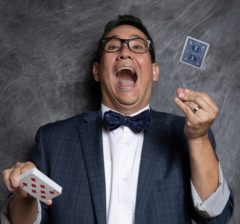Recently someone in a magic group on the internet said that you should give credit during your shows for magic tricks you didn’t create AND for things that inspired the tricks. This is an interesting concept and within magic it’s not really done, outside of a presentation angle. The person thinks you should “live credit” … Continue reading “Why Not To Give Credit…”
Recently someone in a magic group on the internet said that you should give credit during your shows for magic tricks you didn’t create AND for things that inspired the tricks. This is an interesting concept and within magic it’s not really done, outside of a presentation angle.
The person thinks you should “live credit” your tricks to honor the people before you, not for a presentation angle. They then posted a video of them performing, where they say the name of the person whose routine they are doing. Then they say, “I’ll never be able to do it as well as them, but tonight I’m going to try…” There’s a couple of things wrong with that.
First you are telling the audience a story about a show that’s better than your show. Why are we are your show, if there’s a better one? Second is that by trying and succeeding, you are saying you are better than the person you are doing a tribute to. Also in their credit they don’t give us any info on the person whose routine they are doing, and any background about them. It’s simple a credit, not a tribute.
Now here’s an example of it done well:
What makes Penn and Teller’s version good, is they don’t just say the name of the performer, they give a little bio. They also don’t say they will do it better or worse, they let their performance be judged by their performance.
My position on crediting during a show is that you don’t need to do it. It’s stupid and would be an insane waste of time if you had to live credit every move, or bit. You bought the book / DVD / media, the author has gotten compensated, that’s the end of the deal…Unless it’s specifically required by the creator of the trick or bit as a condition of you using it.
Here’s a noteworthy example. Ricky Jay did a trick from Expert at the Card Table, almost exactly as written in the book (moves and patter). He never live credited it to Erdnase in his shows. In fact he got upset when other people did the routine because he thought they wouldn’t have been doing it if they didn’t see him do it!
TLDR: Crediting during your show is a waste of time and dumb.
